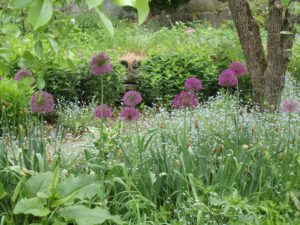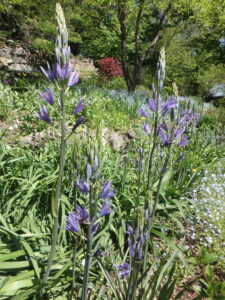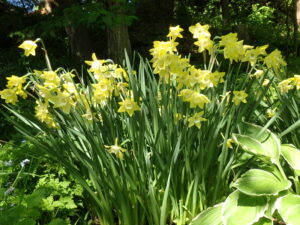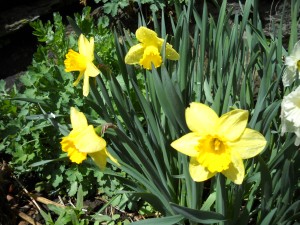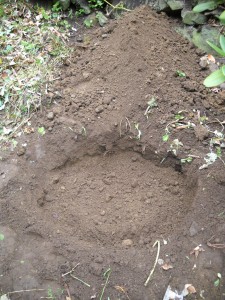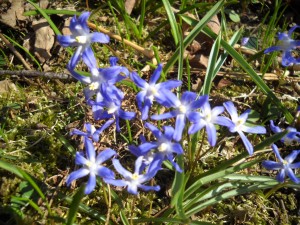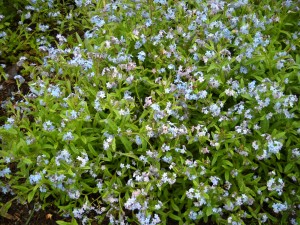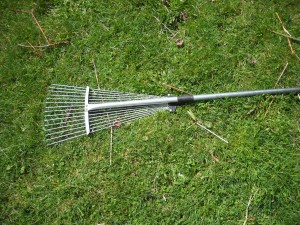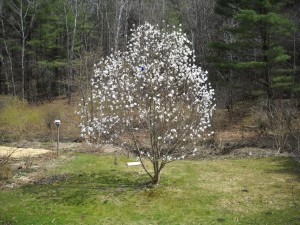Planting Bulbs for Spring Blossoms
First the small bulbs bloom: snowdrops, glory of the snow, scilla, winter aconite and crocus. Next come daffodils, tulips and alliums. Finally come summer snowflake ( Leucojum spp.) and Camassia. You have plenty of time to plant bulbs as you can do so until the ground freezes. But I recommend that you get them now before they are sold out. Gardening has taken a big uptick in interest this year, and I predict bulbs will go the way of seeds and hoses – all sold out early.
Planting depth matters. The small bulbs only need 2 or 3 inches of soil cover over the top of the bulb; bigger bulbs like tulips and daffodils generally need 6 inches of cover. Follow the directions that come with the bulbs.
I like to plant bulbs in big batches. Fifty daffodils will knock your socks off when they bloom, but five will hardly be noticed. I know that some stores sell tools that can be used to cut out and lift a circle of soil all in one motion. The idea is to dig lots of holes (3 inches across) and plant one bulb in each hole. I find that method tedious. The same goes for using an auger on a drill to dig holes for bulbs.
What I like is to dig a bulb bed for 25 or more bulbs. Dig down six inches, remove the soil in an oval or circle 24 to 36 inches across. I put the soil in a wheelbarrow or on a tarp so as to keep the area tidy. Once the hole is excavated, I add some bulb booster or slow-release organic fertilizer in the hole with my CobraHead weeder. I generally add some compost, too, and scratch it into the soil at the bottom of the hole, along with the fertilizer.
There are a few fall blooming bulbs, too. Saffron crocus and Colchicum need to be planted before this, but you might like to try them another year. Colchicum, generally planted in August, is also called “fall crocus” (even though it is not a crocus at all). But the blossoms look like giant crocus, and each bulb produces several blossoms. I love them.
Planting Bulbs
One of my very favorite gardening activities is planting bulbs on a sunny, crisp fall afternoon with Monarch butterflies flitting around and colorful leaves swirling in the air. Each year I plant anywhere between 50 and 300 bulbs and have done so for decades.
I accept that not every bulb I buy is going to last forever. I buy 50 to 100 tulips most years, and consider them annuals because they lose vigor each year, most disappearing after just a few years. I was at a garden center recently and bought 50 mixed tulips for $22. I planted them in one big clump, shoulder-to-shoulder, and will delight in them when they appear. I like tulips as cut flowers and give them away to friends who need a pick-me-up.
Yes, I know that rodents and deer like tulips. In my experience, squirrels dig up bulbs in the fall right after you plant them. They see the fresh, soft earth and say to themselves, Oh Boy! Treats! You can help to keep them from digging up the bulbs by laying chicken wire over the bed, and then covering with chipped branches or mulch of some sort. Not that a determined squirrel couldn’t get to them, it’s just my belief that squirrels are relatively lazy, and there’s plenty of other stuff to eat.
Back at the end of the Clinton era at the White House I got to interview the White House gardener. Gardeners there were busy planting hundreds – perhaps thousands – of a yellow tulip that someone thought Mr. Bush (elected, but not in office at the time) would enjoy. It was called the Hilary Rodham Clinton tulip, and I have never found it for sale, but I like the idea: gardening with giggles.
Anyhow, the Rose Garden is full of big fat gray squirrels. I asked Dale Haney, the gardener, how they dealt with the squirrels, and he told me about the chicken wire technique and one other. Your tax dollars are (or were then) at work buying 50 lb bags of corn. That’s right, they feed the squirrels, keeping them fat and happy, and the squirrels pretty much leave the gardens alone. If you try that approach, please don’t sue me if that only serves to invite all the neighbor squirrels to your yard. It just might.
Deer can be a problem when tulips are ready to bloom. You can repel them by using repellents made for the purpose, available at garden centers. Bobex is one particularly nasty smelling one that they hate. I have sprayed it on shrubs, but if you want to bring tulips into the house, I wouldn’t spray it on the flowers themselves, but around them. It loses its disgusting rotten egg-based smell after 2 to 3 days for us, but lasts much longer for deer.
Bulbs do best in rich, well drained soil. If you have heavy clay, it will stay wet and may rot some of your bulbs. If that is the case, dig a little deeper hole, and put a two-inch layer of compost in the bottom. I never plant bulbs one at a time. I always dig a hole big enough to hold at least a dozen bulbs, and plant them in a mass. It is much more dramatic, come spring.
According to the International Daffodil Register, there are 12 divisions (classifications) of daffodils based on physical looks and genetic background, and one last division based on botanical names only. All are mildly toxic if eaten, so rodents and deer leave them alone. The range of colors and flower type is truly mind-boggling. Go to your local feed-and-grain store or garden center to check out what is available. If you really want the unusual daffies, you may have to go on-line to a company like Brent and Becky’s or McClure and Zimmerman.
I like to plant early, mid-season and late-blooming daffodils, and read the labels carefully when buying to see their bloom season. One trick to keep in mind next spring is this: cut the spent flowers off after blooming, so the plants do not waste energy making seeds. But don’t cut back the foliage until it turns brown. The leaves are “re-charging” the bulbs. I like to plant clumps of daffies between clumps of hostas – the hosta leaves hide the daffodil foliage after blooming.
Get adventurous when you plant this year. A great early summer bloomer is giant snowflake (Leucojum aestivum) which looks like a snowdrop on steroids. These lovelies are 12 or more inches tall and are nice cut flowers. Snowdrops, of course, are essential to any garden. If you plant them on a south-facing hillside, you should get blossoms in early March unless they are planted where snow slides off the roof.
So get outdoors and plant bulbs. You’ll be rewarded with blossoms just when you need them most – after the dreariness of winter.
Web Extra: Other great bulb plants include Scilla and glory of the snow, both very early blooming. Both are blue to purple, and quite short – 4 inches tall or so. Scilla blossoms look down, while glory of the snow looks up and shows it white and yellow throat. Don’t dismiss them as cut flowers just because they are short – they are available when other things are not.
Winter aconite is lovely, too. This is an early yellow flower that is low to the ground. It has 5 or 6 petals that look up, as bright as any daffodil. It is marginally hardy in my Zone 4 garden, and I seem to lose them some times, but I consider them worth re-planting to keep a small supply going.
Henry’s new book, Wobar and the Quest for the Magic Calumet will be in bookstores October 15. For information about it go to Henry’s Web site, www.Gardening-Guy.com.
Spring Forth Into Spring
This is a busy time for all of us in the garden. Not only are weeds up, some of them are already blooming. I try real hard to keep weeds from spreading their seeds in my garden beds, so I am doing my best to pull them now before they bloom and make seeds. And there is so much else to do I’m not sure if I have time to write this column!
Apple and crabapple trees are blooming everywhere, which draws my eyes to them. I can’t help but notice that so many need a little late pruning. What I keep seeing are root sprouts coming up alongside the trunk of these lovely trees, which is a distraction. And it only takes 5 minutes with a pair of loppers or a hand saw to remove those shoots.
While you’re at it, you may wish to take off any little branches that are sprouting from the main trunk below the first scaffold branches (those larger branches that reach out and up, and that have all those blossoms on them). A nice clean trunk is much better than one cluttered with unwanted sprouts.
Then there is the vegetable garden. I know we will still have frost here in Cornish Flat, so all those tomatoes and peppers and squash that I have started by seed inside need to stay in their pots. What I can do now, however, is” harden off” those seedlings. Hardening off is the process of getting seedlings ready for life outdoors.
Each nice day I should (but don’t always) carry all 12 trays of seedlings outdoors so my plants can work on their tan. That’s right, seedlings are like us – they need to start with just a little sunshine and breeze each day. Two hours of morning sun is good for a start, then 4 hours, then 2 hours of afternoon sun, and so on, increasing exposure until their leaves won’t burn or dry out even if they’re in the sun all day. If you buy seedlings it’s good to give them time to get used to the outdoors, too. Greenhouses do shelter seedlings considerably.
Right now I have thousands of forget-me-nots (Myosotis sylvatica) blooming everywhere: in garden beds, in the lawn, in the vegetable garden – even on the banks of my little stream (they love water). If you don’t have this fabulous, exuberant flower, you should. I wish I could give every reader a clump, but I bet one of your neighbors will share some with you, as most everyone has it. I rarely see them for sale at nurseries, but a few of the better ones do. Many flower books say they are biennials, but I’m not sure that’s true. Biennials only bloom in their second year, and then die. I have so many, it’s hard to know if they are re-seeding or coming back from their roots. So they may be perennials.
While weeding a patch of daffodils recently, I decided to take advantage of the fact that I had thoroughly loosened the soil surface. I spread my favorite organic fertilizer, Pro-Gro over the soil surface and scratched it in with my favorite weeder, the CobraHead. I had notice that those daffies were not flowering as previous years and decided to give the soil some extra nutrition and get rid of the weeds that were competing with them. Next spring I should have better blossoms.
Some gardeners like to divide big clumps of daffodils, though I generally don’t get around to it. The problem is that by fall I don’t know where those big clumps that need dividing are. The solution? Make some markers now and stick them in the soil. That works for marking places that need more bulbs, too.
It’s past time to rake off that leaf mulch or straw if you covered your vegetable garden with mulch last fall. I just raked mulch off my beds and into the walkways last week. By exposing the soil to the sun I do 2 things: I let the soil warm up and dry out more quickly, and I encourage weed seeds to germinate. I want the weeds to germinate before I plant so that I can hoe them over or pull them out, killing them before I plant. I also have a flame weeder which will burn off dozens of small annual weeds with a single, quick pass. (Available at Johnny’s Seeds or Fedco Seeds). But it does use propane, so is not as eco-friendly as hoeing.
Traditional gardeners grow their carrots, corn and cauliflower in narrow rows on flat ground. I don’t. I have mounded up beds that are 3 feet wide and 6 to 8 inches higher than the walkways. Wide beds produce more planting space in a garden when compared to those with narrow rows because there are fewer walkways. The wide, higher beds allow roots to spread wider and deeper than in traditional beds, and dogs and kids tend to stay out of them.
But if you have a sunny, warm weekend, don’t spend all day pulling weeds or working. Take time to sit and enjoy your flowers – and the butterflies, kids and dogs that love the garden, too.
Henry’s Web site is www.Gardening-Guy.com. It now has a search engine for finding any past columns you might have missed.
Spring Tasks in the Garden
April has been a busy month for most gardeners because it has been warm and sunny. Our flower gardens and trees have woken up early, allowing us to do tasks we might, in other years, put off until May. Here are some jobs I‘ve been working on – and you should be, too.
Raking the lawn. Always one of my least favorite jobs, it needs to be done if you want a good looking lawn. But really, there are only 2 places where it’s critical: First, remove the piles of sand and gravel dumped along the edge of the driveway by the snowplow. Your lawn will suffer if they aren’t removed. Second, harvest the soil pushed up by moles in the lawn. I collect the soil from those piles and use it as fill dirt. The rest of the lawn? Any dead leaves will be chopped up by the lawnmower and disappear – and add some nice organic matter to your lawn’s soil.
Raking the flowerbeds. This I enjoy. I love seeing what plants have come safely through the winter, what is waking up and sending forth shoots. I rake carefully, so as not to break off the growing tips of peonies or other delicate flowers. I start with a rake to clean up around a clump of shoots, and then bend over to gently “rake” the clump itself with my fingers. I use an expanding lawn rake with a telescopic handle. I can adjust the width of the rake from about 7 inches to about 22 inches, allowing me to rake carefully in-between plants. I found the rake locally at my feed-n-grain store.
Pruning. I’m mostly done with this spring task, but I’m still tweaking apple and pear trees as I walk around the property with a holstered pruner on my hip. Recently I cleaned up lots of root suckers –shoots – coming up around the base of a crab apple tree. And I shaped up my roses, cutting back long, lanky stems to create nicely rounded plants.
I just finished pruning my grapes. They need to be cut back severely each year, as they would get too unruly if I didn’t. They produce grapes on new growth, which is stimulated by pruning. I have a 2-wire system on the south side of my barn and prune back to thicker, older canes and the 6-inch spurs that I allow to grow off them.
Planting. At this time of year my garden soil is usually cold and wet. Not so this year. I have planted seeds for carrots, beets, parsnips, scorzonera, salsify (all are root crops), parsley, spinach and greens. Peas could be planted now, though I have decided to skip them this year. I also have transplanted little lettuce plants and other interesting greens that I started indoors at the end of March, including chicory and mesclun. Some folks I know have already planted potatoes, but I wait until June.
I believe (but cannot prove) that planting potatoes in June helps to reduce problems with potato beetles. I like to say they’ve already gone to my neighbors’ potatoes, so avoid mine. But who knows? I watch for the beetles and pick any I find early on, so (hopefully) few produce a second generation.
That same technique works on slugs: control them early to prevent big outbreaks later on. I use an organic slug control product, Sluggo, which is iron phosphate covered with slug bait. Iron phosphate is a naturally occurring mineral that is said to be safe for pets and wildlife – and approved for organic gardeners.
Last fall I neglected to work on my blackberry patch, so I’ve been cleaning it up now, along with help from my intern, Gordon Moore. He cut out all last year’s fruiting canes (which die after bearing fruit). The patch has gotten to be 10 to 12 feet across, so we created a path down the middle of it by pulling out plants as needed. Then we pinned down a 2-foot wide strip of heavy landscape fabric (using landscape staples) and he covered it with a 2-inch layer of chipped branches I got from an arborist.
I weeded the patch and top dressed it with organic fertilizer and other minerals including green sand and Azomite. Green sand provides extra potassium and micronutrients from the sea. Azomite is a brand- named product that contains a wide array of finely ground rocks to provide micronutrients. After adding those minerals, we spread chipped branches around the plants, too.
To keep the blackberries from flopping over when laden with fruit, I have a 2-wire fence on the outside. The lower strand is 30 inches off the ground, the upper is 60 inches. Gordon and I tightened up the fence, which had gotten floppy. Along the center walkway I tied canes to 5-foot grade stakes as needed. It’s a huge improvement! (There’ll be no more need for blood transfusions after picking berries.)
Finally, I spend time right now admiring my flowers. My Merrill magnolia tree has been spectacular and fragrant. Shad bushes, a native plant (Amelanchier spp.), are in full bloom now- both the planted ones and those at the edge of the road and field. All my daffodils – early, mid-season and late – bloomed at the same time this year, so I am picking them and bringing inside to enjoy. I hope you will find time, too, to slow down and enjoy your flowers.
Henry Homeyer is a life-long organic gardener and the author of 4 gardening books. His Web site is www.Gardening-Guy.com



